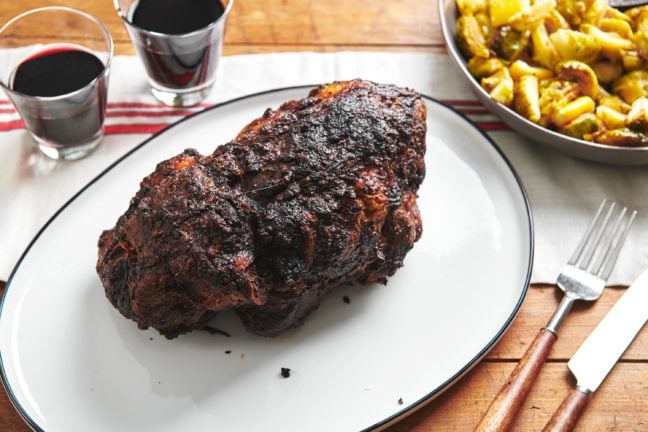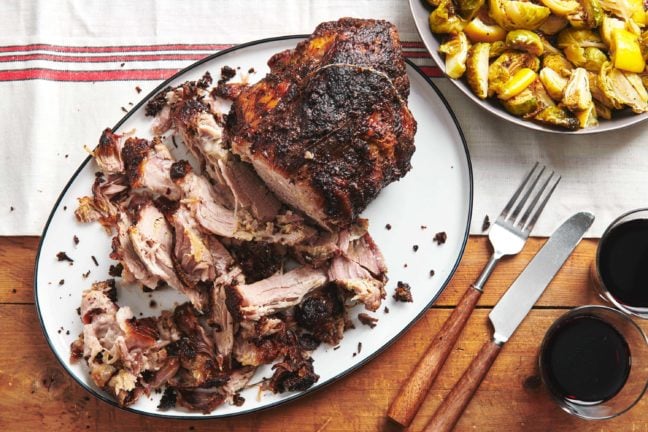A marinated pork shoulder or butt roast recipe that is slow-cooked and very tender. It tastes great on its own and can be used in a lot of different ways. One of my go-to dishes for casual crowd entertaining.
A juicy, fall-apart tender pork butt roast makes for an incredible entrée for a special dinner or celebration. While it requires time and patience the results are so worth it! But getting the timing right can be tricky when cooking pork roast in the oven. Let’s walk through everything you need to know for oven-roasted pork butt perfection.
Why Roast Pork Butt?
- Infuses with flavor from spices, rubs and marinades
- Cooks low and slow to maximize tenderness
- Requires minimal hands-on time
- Feeds a crowd affordably
Roasting is a simple, foolproof cooking method that transforms tough pork butt into succulent, pull-apart meat with little effort
How Long Does Pork Butt Take to Cook?
Due to its high fat content and connective tissue, pork butt needs prolonged cooking to reach fall-off-the-bone doneness. Here are general guidelines:
- 5-7 pounds – Allow 1.5-2 hours per pound
- 3-4 pounds – Allow 1.5-1.75 hours per pound
- Under 3 pounds – Allow 1.25-1.5 hours per pound
For example, a 6 pound pork butt roast may take 9-12 hours in the oven. The exact time will depend on your specific cut and oven.
What Temperature for Pork Butt Roast?
Ideally, pork butt should roast low and slow at 225-275°F. This gives the fat and collagen time to melt and break down into succulent meat.
Higher heat around 325°F can work if you’re short on time, but monitor closely to avoid drying out the exterior before the inside cooks through.
How to Tell When It’s Done
Pork butt roast is technically safe to eat at 145°F, but won’t be pull-apart tender yet. Continue roasting until it hits 195-205°F internally.
Use an instant read thermometer to test the thickest part of the roast. The meat should shred easily when poked with a fork at this stage.
Seasoning is Key
A bold spice rub or marinade adds tons of flavor. Try:
- Brown sugar, chili powder, paprika, garlic
- Apple cider vinegar, mustard, oregano, olive oil
- Coffee, cumin, smoked paprika, oregano
Really work the seasoning into the meat. Let it sit for 30-60 minutes before roasting for complete flavor absorption.
Maintain Moisture
Pork butt has a tendency to dry out during the long cooking time. Here are some tips to keep it juicy:
-
Brine the meat before roasting
-
Spritz with apple cider vinegar during cooking
-
Place roast in a covered roasting pan with 1 cup broth
-
Wrap with foil after the first 2-3 hours
-
Allow roasted meat to rest 30 minutes before pulling
Roasting Vessel Options
You can use various vessels to roast pork butt in the oven:
-
Rimmed baking sheet – Good for smaller roasts
-
Roasting pan with rack – Allows air circulation
-
Heavy Dutch oven – Retains moisture well
-
Disposable foil roasting pan – For easy cleanup
No matter what you use, elevate the pork on a rack above the bottom of the pan. This exposes more surface area to heat and air for even cooking.
Serve it with Classic Sides
While pork butt roast needs no accompaniment, classic BBQ sides always pair nicely. Consider:
- Baked beans
- Coleslaw
- Cornbread or rolls
- Roasted potatoes
- Collard greens
- Mac and cheese
- Fruit salad
Serve the meat piled high on rolls for pulled pork sandwiches too!
Expert Tips and Tricks
-
Pat the pork dry before seasoning for better spice adhesion
-
Flip the roast over halfway through cooking
-
Add broth or water to pan drippings for basting
-
Cover roast loosely with foil to prevent drying
-
Start checking temperature after 75% of cook time
-
Let roasted pork rest at least 20-30 minutes before pulling
Make-Ahead and Freezer Tips
-
Roast a day ahead – refrigerate tightly wrapped.
-
Heat leftovers gently in the oven at 250°F.
-
Let roasted pork cool completely before freezing.
-
Thaw frozen pork overnight in the refrigerator.
-
Reheat thawed pork butt in a 300°F oven until heated through.
Frequently Asked Questions
What if I don’t have 12+ hours for roasting?
Opt for a smaller 3-4 pound pork butt. Or, cook in the Instant Pot on high pressure for 90 minutes followed by natural release.
Can I speed up the cooking time at all?
Not without sacrificing tenderness. Roasting low and slow is essential. If extremely pressed for time, roast at a higher temp while monitoring closely.
Do I need to sear or brown the meat first?
Browning isn’t required, but it adds nice color and flavor. Quickly sear all sides in a hot pan before roasting if desired.
Should I wrap the pork roast in foil while cooking?
You can lightly tent foil over the pork after the first few hours of roasting. This steams the meat and retains moisture.
Can I roast pork butt at a higher oven temp like 350°F?
While possible, the pork roast may dry out on the exterior before the inside cooks through. Stick to 225-275°F for best results.
The Takeaway
For tender, juicy pulled pork, roast the butt low and slow in a 225-275°F oven. Figure on 1-2 hours per pound, and cook until it reaches 195-205°F internally. Rest before pulling for maximum juiciness!

How to Cook Pork Shoulder Roast
Chris told me that a chef told him a long time ago that meat tastes best when it’s cooked at about the same temperature it reached when it was done.
I don’t think that’s always the case (flame-kissed steaks and burgers anyone?), but it made sense when I thought about it in terms of a big piece of tough meat, like this boneless pork shoulder roast, that needs to be cooked slowly and low to make it go from being impossible to tender. It won’t help to try to speed things up; you need to keep the heat low and the time long.
You can also use a pork butt roast or Boston Butt pork roast for this recipe and others like it. These are also from the shoulder area, but a little higher up. They are basically the same cut of meat.

Fat Side Down or Up?
You can use bone-in pork shoulder instead of boneless pork shoulder because it will cook in about the same amount of time. Some cook faster than others. The directions say to put the fat side down in the pan so that the top can get a nice crust, but it doesn’t really matter. There is less crusty top when there is fat on top, which kind of bastes the pork as it cooks. Your call, you won’t go wrong.
The best part is that you have time to read, dance, sleep, clean your closet, or save kittens from trees.

